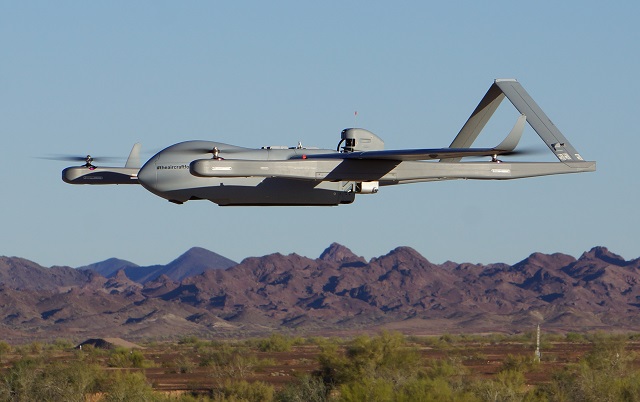Textron Systems says it has successfully demonstrated a vertical takeoff and landing (VTOL) with its Aerosonde unmanned air vehicle using the hybrid quadcopter technology that it is pursuing along with Latitude Engineering and Cloud Cap Technology.
The recent demonstration in Hunt Valley, Maryland, saw an Aerosonde adapted with a multi-rotor system lift off and land vertically, as opposed to being catapult-launched and recovered via a catch net.

Textron Systems
The small, expeditionary UAV has a maximum gross takeoff weight of 17.5kg (38.5lb) or 25kg, depending on its engine configuration. It is widely deployed in support of American-led combat operations.
Adding a hybrid quadrotor system to the Lycoming EL-005 heavy fuel engine-powered UAV would allow it to deploy from almost anywhere with much less of a logistical footprint than if it required a standard launch and recovery system.
Aerosonde is equipped with various sensors, primarily an electro-optical/infrared full-motion video camera, and it can also act as a communications relay between troop in places with spotty radio connectivity, like mountains or valleys.
“The Textron Systems’ proof-of-concept work combines the vertical takeoff and landing capabilities of a multirotor platform with the efficiency, speed and endurance of the Aerosonde [small unmaned air system] fixed-wing aircraft,” says Textron. “With the addition of VTOL capabilities, the system retains service-proven capability within a smaller, more portable footprint.”
In another development at Textron Systems, the unmanned aircraft division recently received $116.5 million from the US Army for another 24 of its mainstay product, the RQ-7B Version 2 Shadow.
The army is the process of modernising its tactical Shadow fleet as the aircraft is paired with the Boeing AH-64 Apache gunship in an aerial scout role. The "V2" is an all-digital, multi-mission system used primarily for intelligence, surveillance and reconnaissance, communications relay and laser designation missions.
The US military counts 117 Shadow systems in its inventory, and Australia, Italy and Sweden also operate the type. The next 24 systems will be delivered to the US government in 2018.
Source: FlightGlobal.com


























